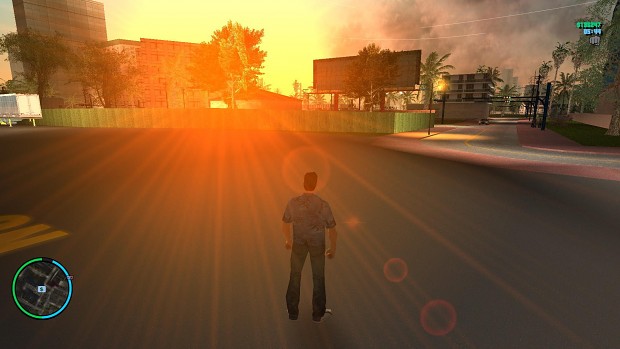As impressed as I am with the quality of animation in films, television shows, and video games these days, I do have a minor objection. I think the animators and art directors are trying way too hard to make the images as “realistic” as possible. By that, I don’t mean to say that the Final Fantasy movie pissed me off because Aki Ross’s hair was so complex and lifelike. That was cool. What I am objecting to is the animators’ insistence on including an artificial lens flare when the camera angle calls for a direct view into a sunset.
I hate that lens flare. It’s been included in numerous cinematic cut scenes in video games (Grand Theft Auto III, Grand Theft Auto: Vice City and Metal Gear Solid 2, just to name a few), and of course, in animated films and television shows (The Lion King, Final Fantasy: The Spirits Within, and Beast Wars: Transformers). Now, I think I understand the rationale for adding that lens flare. The creative art directors eagerly want to show off their careful attention to detail, so they try to make it appear as though the fabricated images on the screen were actually captured by real-life cameras. I remember the first time I saw the lens flare in a real-life motion picture. It was during a Crocodile Dundee movie. I was so confused by the little shiny circles at the bottom of the screen, that I thought about them for the rest of the movie. Mind you, I didn’t miss too much in my daydreaming haze…it was only Crocodile Dundee, after all. But my point is, the lens flare is both a limitation of filming technology as well as it is a distraction to audiences.

So why bother including the lens flare in works of animation? Whenever I see it in a cartoon or a video game, I’m not impressed–I’m distracted. I look to the bottom of the screen, marveling at the futility of including the little circles while I should be caught up in the moment, becoming enchanted with the intricate scenery and getting lost in the fictional world that’s being laid before me. Arguably, the best kind of storytelling allows an audience a chance to escape reality, which is why works of animation are so special. They allow the impossible to happen, because they aren’t true reflections of reality. In that Muppet Babies show, do you remember baby Kermit ever having to rely on little black wires and a puppeteer to move his arms around? In those animated Peanuts specials, can you recall a time when Snoopy (who, after all, is only a dog) ever had hard time balancing on his hind legs? Whenever Rocky J. Squirrel took flight, did you ever see a support wire attached to his waist? The answer to all of those questions, of course, is no. Animation allows its individual characters and its fictional worlds to defy the limitations of reality. Animators should keep that in mind. When you create a reality in which anything is possible, do yourself a favor and allow your mind to roam freely. There’s no point in fantasizing if you can’t learn to make the most of it.

